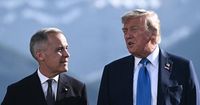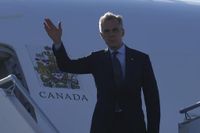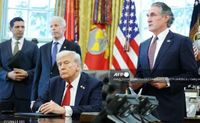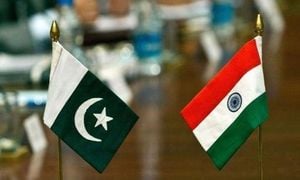On Tuesday, October 7, 2025, Canadian Prime Minister Mark Carney stepped into the Oval Office for his second meeting with U.S. President Donald Trump since taking office in April. The stakes for this visit couldn’t have been higher. Relations between Canada and the United States—long considered one of the world’s most enduring and amicable alliances—have hit what many observers are calling a historic low, battered by Trump’s aggressive trade tactics and even talk of annexation.
Carney’s visit, described by Ottawa as a “working visit,” came at a moment of mounting economic and political pressure at home. The Canadian economy has been feeling the squeeze: a 1.5% decline in GDP during the second quarter of 2025, and new tariffs on Canadian goods have stoked fears of a deeper downturn. According to The Associated Press, more than 77% of Canada’s exports are destined for the U.S., making the relationship critical to Canada’s economic health.
At the heart of the current tensions are tariffs—steep ones. Trump’s administration has imposed 50% tariffs on Canadian steel and aluminum under Section 232, along with levies on lumber, automobiles, and, most recently, a new 25% tariff on heavy trucks set to take effect November 1. The president has justified these moves by arguing that “a lot of companies from Canada are moving into the United States,” and that Carney “is losing a lot of companies in Canada.” As AFP reported, Trump has also called for a revision of the United States-Mexico-Canada Agreement (USMCA) that would further favor American industries. The USMCA, up for review in 2026, currently protects the majority of North American trade, but its future is now in question.
Carney’s mission in Washington was clear: convince Trump to ease the tariffs that are battering Canadian industries and restore some measure of trust in the bilateral relationship. But expectations were tempered. “Improving relations with the White House ahead of the USMCA review is certainly an objective of the trip, but opposition parties and part of the Canadian public will criticize Prime Minister Carney if he doesn’t achieve some progress on the tariff front at this stage,” Daniel Béland, a political science professor at McGill University, told The Associated Press.
Inside Canada, the pressure on Carney has been intense. As a former central banker who campaigned on crisis management, Carney has found himself under fire for making concessions to the U.S.—such as canceling a tax targeting American tech giants and lifting tariffs imposed by the previous government—without receiving any reciprocal moves from Washington. “Mark Carney has no choice, he must return from Washington with progress,” Béland insisted. Conservative opposition leader Pierre Poilievre was even more direct, warning in an open letter, “If you return with excuses, broken promises and photo ops, you will have failed our workers, our businesses and our country.”
The relationship between the two countries is more than just numbers on a trade ledger. About $2.5 billion (nearly $3.6 billion Canadian) worth of goods and services cross the border each day. Canada is the top export destination for 36 U.S. states, and the two nations share deep ties in defense, border security, law enforcement, and culture. Canada supplies about 60% of U.S. crude oil imports and 85% of its electricity imports, and it remains the largest foreign supplier of steel, aluminum, and uranium to the U.S. The Pentagon, for its part, is eyeing Canada’s 34 critical minerals and metals as essential for national security.
Yet, the mood in Canada has turned sour. Frank McKenna, former Canadian ambassador to the United States and deputy chairman of TD Bank, summed up the national mood: “We’ve had ups and downs, but this is the lowest point in relations that I can recall. Canadians aren’t being instructed what to do. They are simply voting with their feet. I talk every day to ordinary citizens who are changing their vacation plans, and I talk to large business owners who are moving reward trips away or executive business trips. There is an outright rebellion.”
Amid this backdrop, Trump’s recent comments about annexing Canada—suggesting the country become the “51st state” of the U.S.—have only inflamed tensions. During a speech to U.S. generals and admirals, Trump claimed, “Canada called me a couple of weeks ago, they want to be part of it,” referencing a new “Golden Dome” missile shield. “To which I said, well, why don’t you just join our country and become the 51st state, and you get it for free.” The remarks, though delivered with a characteristic mix of bravado and humor, have not sat well north of the border, where many see them as a sign of disrespect or, at best, tone-deafness during a fraught moment.
Despite the harsh rhetoric and economic strain, the USMCA still offers some protection. Carney has pointed out that more than 85% of Canada-U.S. trade continues to be free of tariffs, and the average U.S. tariff rate on Canadian goods remains the lowest among all American trading partners at 5.6%. But sector-specific tariffs—especially on steel and aluminum—are inflicting real pain. There is talk that Canada might get some relief, perhaps with tariffs dropping from 50% to 25% or through tariff-free quotas matching last year’s levels. “The bigger prize would be getting a mutual agreement to negotiate as quickly as possible the free trade relationship,” said McKenna. “If the United States were to threaten us with the six months’ notice of termination, I think it would represent a deep chill all across North America.”
While Carney’s trip aimed to patch up a battered alliance, the odds of a breakthrough seemed slim. White House spokeswoman Karoline Leavitt confirmed trade would be a key topic, but also noted, “all of the other issues that are facing both Canada and the United States” would be on the table. Genevieve Tellier, a political scientist at the University of Ottawa, cautioned, “they are also aware there’s always a risk when negotiating with Donald Trump. These meetings can easily go off track, and everything plays out publicly.”
For now, Canadians are left watching and waiting, their economic fortunes and sense of national pride riding on the outcome of a single meeting in Washington. Whether Carney returns home with tangible results or just another round of photo ops remains to be seen, but the message from his critics is clear: the time for excuses is over.
As the dust settles, both nations face a crossroads. Their economic ties are deep, their histories intertwined, but trust is in short supply. The next move, as always, will be watched closely on both sides of the world’s longest undefended border.






